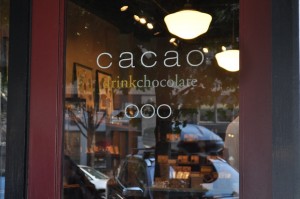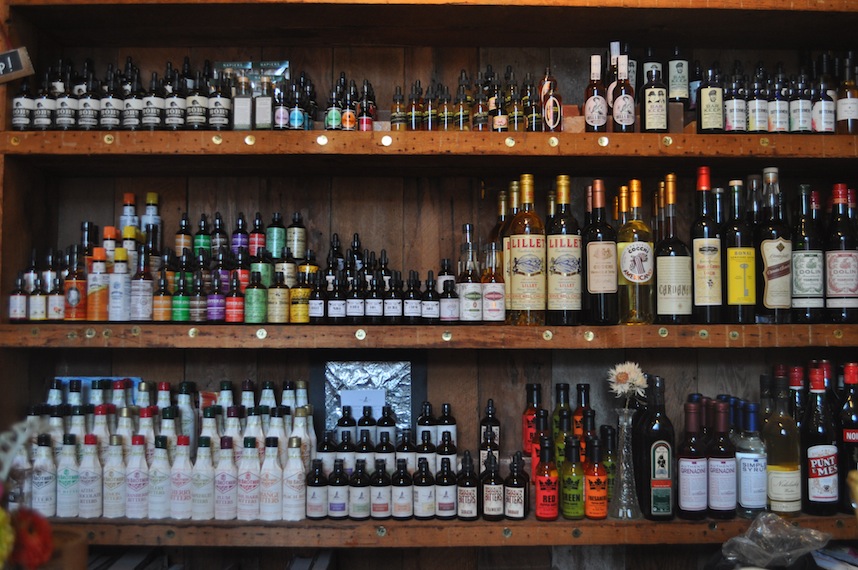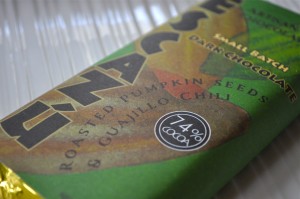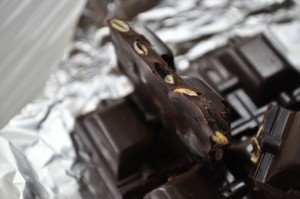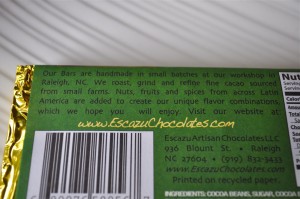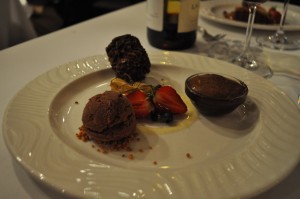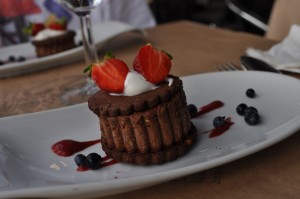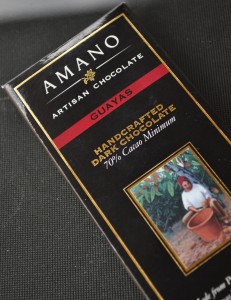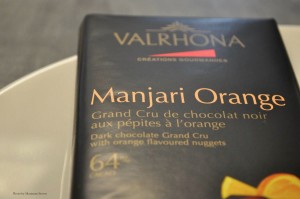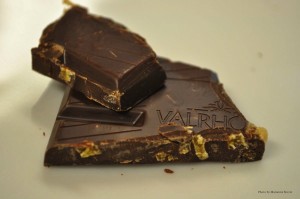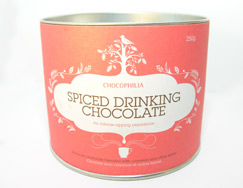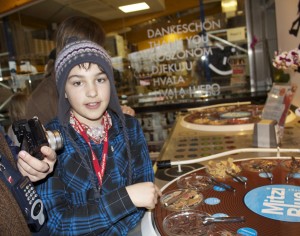
 During Easter vacation we decided to visit the Zotter chocolate factory in Riegersburg, Austria which is about 1.5 hours south of Vienna in the middle of nowhere. For those not familiar with the Zotter brand, he is a famous Austrian chocolatier who those zany truffle bars with unique flavor combinations such as cheese and wine, peanuts and ketchup (the American bar), celery root and pineapple, and pork cracklins- which sounds really weird but is actually pretty good. Since 2008 I have sold his bars on and off at Kerstin’s Chocolates. He also makes chocolate bars, a line of drinking chocolate, and many other things as I soon discovered. The tour of the factory is really a multi-sensory experience that allows you to see and learn about how things are done in the factory all the while eating your way through all the Zotter creations. For 12 euros (and a little less for kids) you can taste everything he makes, which is about 300 varieties! The tour starts at the Chocolate “theatre” where you see a film that shows Zotter sourcing his beans in India. I found this interesting because India isn’t well known as a cocoa growing country. It made more sense once we learned that he has started a project where every time he sells a bar made with Indian beans, one child in the program gets served a meal. To learn more, click here: http://www.zotter.at/de/das-ist-zotter/projekte/schokolade-macht-satt.html
During Easter vacation we decided to visit the Zotter chocolate factory in Riegersburg, Austria which is about 1.5 hours south of Vienna in the middle of nowhere. For those not familiar with the Zotter brand, he is a famous Austrian chocolatier who those zany truffle bars with unique flavor combinations such as cheese and wine, peanuts and ketchup (the American bar), celery root and pineapple, and pork cracklins- which sounds really weird but is actually pretty good. Since 2008 I have sold his bars on and off at Kerstin’s Chocolates. He also makes chocolate bars, a line of drinking chocolate, and many other things as I soon discovered. The tour of the factory is really a multi-sensory experience that allows you to see and learn about how things are done in the factory all the while eating your way through all the Zotter creations. For 12 euros (and a little less for kids) you can taste everything he makes, which is about 300 varieties! The tour starts at the Chocolate “theatre” where you see a film that shows Zotter sourcing his beans in India. I found this interesting because India isn’t well known as a cocoa growing country. It made more sense once we learned that he has started a project where every time he sells a bar made with Indian beans, one child in the program gets served a meal. To learn more, click here: http://www.zotter.at/de/das-ist-zotter/projekte/schokolade-macht-satt.html 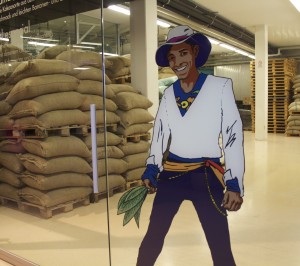 According to the movie, he pays twice the market price for organic beans and he can trace the beans back to the individual farmer in India. There is a big focus on tranparency, not just in the sourcing of the beans, but in the factory tour as well, inviting visitors to get up close and personal with each stage of the chocolate making process from start to finish.
According to the movie, he pays twice the market price for organic beans and he can trace the beans back to the individual farmer in India. There is a big focus on tranparency, not just in the sourcing of the beans, but in the factory tour as well, inviting visitors to get up close and personal with each stage of the chocolate making process from start to finish. 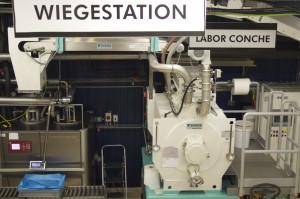 The first stop is the loading bay. You see piles of jute bags filled with cocoa beans from different countries through a viewing window. In the adjacent tasting room, you can sample these beans in their raw form to taste the differences depending on the bean’s origin. Next we see the chocolate making equipment as our audio guide explain the uses of each machine. The chocolate is available to taste during the different stages of processing, including the nibs, the 100% liquid chocolate, and the powdered form before it hits the conche. The next section is where things get more exciting. At the “Shokotankstelle” or the chocolate filling station, we sample the different types of chocolate in liquid form, all of the Zotter blends. You might be compelled to stick your head under the tap and pour the liquid chocolate straight in your mouth, but instead you are asked to use a ceramic spoon that is given to you at the beginning of the tour. You can fill it with whatever and however much you want. I tried to pace myself but it quickly turned into a free for all as I began to realize just how many different kinds of chocolate Zotter makes and that they are all there to sample. After the “tankstelle” we were invited to climb the “chocolate stairway to heaven”.
The first stop is the loading bay. You see piles of jute bags filled with cocoa beans from different countries through a viewing window. In the adjacent tasting room, you can sample these beans in their raw form to taste the differences depending on the bean’s origin. Next we see the chocolate making equipment as our audio guide explain the uses of each machine. The chocolate is available to taste during the different stages of processing, including the nibs, the 100% liquid chocolate, and the powdered form before it hits the conche. The next section is where things get more exciting. At the “Shokotankstelle” or the chocolate filling station, we sample the different types of chocolate in liquid form, all of the Zotter blends. You might be compelled to stick your head under the tap and pour the liquid chocolate straight in your mouth, but instead you are asked to use a ceramic spoon that is given to you at the beginning of the tour. You can fill it with whatever and however much you want. I tried to pace myself but it quickly turned into a free for all as I began to realize just how many different kinds of chocolate Zotter makes and that they are all there to sample. After the “tankstelle” we were invited to climb the “chocolate stairway to heaven”. 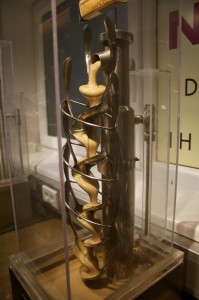 Here you could try all the different “Lambooka” bars which start with flavored white chocolate bars such as strawberry and banana and end with a pure 100% bar. The chocolate stairway faces a series of conveyor belts where the ganaches are poured, enrobed and cooled and where the finished ganache bars are packaged. Unfortunately we picked Good Friday to visit so we couldn’t see any work being done, but I didn’t really care at this point because I was on a sugar high and heading towards the hot chocolate station.
Here you could try all the different “Lambooka” bars which start with flavored white chocolate bars such as strawberry and banana and end with a pure 100% bar. The chocolate stairway faces a series of conveyor belts where the ganaches are poured, enrobed and cooled and where the finished ganache bars are packaged. Unfortunately we picked Good Friday to visit so we couldn’t see any work being done, but I didn’t really care at this point because I was on a sugar high and heading towards the hot chocolate station. 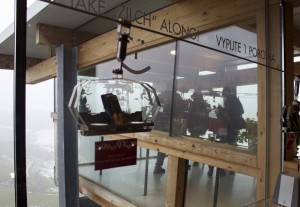 When I got there, an attendent behind the bar was waiting to hand me a cup of hot milk. She told me to chose a hot chocolate flavor from the miniture gondolas that encircled us overhead and around the room. I chose chili, and plopped it into my milk (it was a solid piece of chocolate) and began whisking with my own personal whisk. All of this was really fun and pretty soon I was no longer a reviewer but overcome with the same enthusiasm as all the other Zotter customers.
When I got there, an attendent behind the bar was waiting to hand me a cup of hot milk. She told me to chose a hot chocolate flavor from the miniture gondolas that encircled us overhead and around the room. I chose chili, and plopped it into my milk (it was a solid piece of chocolate) and began whisking with my own personal whisk. All of this was really fun and pretty soon I was no longer a reviewer but overcome with the same enthusiasm as all the other Zotter customers. 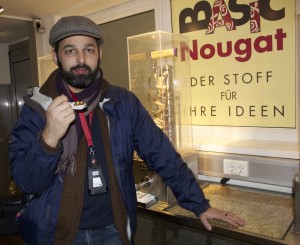
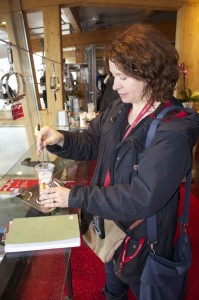 After the hot chocolate station, there was the Nougat station (the walnut was really good), the Bollero station (the fruit and nut one was my top choice) and it all ended to my surprise with the Zotter filled bars. How could I have forgotten about the filled bars? And how can I eat any more chocolate? Of course, I could eat more chocolate and I did. I tried all of them because, finally I could!
After the hot chocolate station, there was the Nougat station (the walnut was really good), the Bollero station (the fruit and nut one was my top choice) and it all ended to my surprise with the Zotter filled bars. How could I have forgotten about the filled bars? And how can I eat any more chocolate? Of course, I could eat more chocolate and I did. I tried all of them because, finally I could! 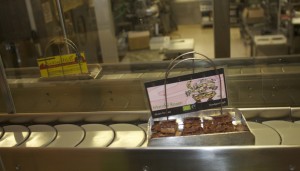 The tour was a blast and I thought they did a great job of both educating customers and entertaining them at the same time. Zotter really has a cult of personality thing going on and we gobbled it all up.
The tour was a blast and I thought they did a great job of both educating customers and entertaining them at the same time. Zotter really has a cult of personality thing going on and we gobbled it all up.
Category Archives: Reviews
Tell us about your favourite bar…

We’ve been choosing our favourite bars over the past few months, and for December’s ‘Pick of the Month’, we’d like a little help.
Leave a comment below (or e-mail us at marianne [at] kerstinschocolates [dot] com) telling us why your favourite bar should be December’s feature. We’ll pick the most passionate response and give the winner their favourite bar on the house.
There are a couple caveats:
Firstly, no Porcelana.
Secondly, we like to use the monthly features to highlight some of our single origin/imported selections that people might not normally pick up. So no Chocophilia bars, please.
Other than that, any bar in the shop is game. We’ve now received all our Amedei, Amano, Madécasse, Askinosie, Bonnat, Michel Cluizel and François Pralus, so there’s lots to choose from. Happy tasting!
_____________________________________________________________________________________________
Edit: Here’s a list of bars currently at the shop. Madécasse has been left out since they were featured in our November pick.
Amano – Ocumare 70%, Ocumare 30%, Dos Rios, Guayas, Morobe, Cuyagua (Limited Edition), Montanya (Limited Edition)
Domori – Lattesal, Biancomenta, Cappuccino, Latteamaranth, Peperoncino, Biancoliquiriquia
Amedei – ‘9’, Chuao, Toscana Black 70%
Michel Cluizel – Los Anconès, Concepcion, Vila Gracinda
Bonnat – Madagascar 75%, Asfarth (dark milk), Surabaya (dark milk), Java (dark milk)
François Pralus – Indonesie, Tanzanie, Trinidad, Colombie
Askinosie – Del Tambo, Tenende Tanzania, Nibble-bar
TAZA – 60%, 70%, 80%
Patric – 75% Madagascar, PBJ OMG, Mint OMG, Mocha OMG, Cappuccino
November Bar of the Month: Madécasse 67%
Madécasse sent us a brand new shipment towards the end of October, and we quickly re-fell in love with their 67%.
All of Madécasse’s bars are not only made with Madagascan beans, but are manufactured in Madagascar as well, a practice which is thankfully becoming more common with dedicated chocolate-makers. It’s always helpful to know that chocolate can be an ‘ethical idulgence’!
Many of you know and love the overt tart flavour typical to bars from Madagascar – the Pralus and Patric versions, both fast sellers at the shop, are probably the most notable among citrus-lovers. This 67%, I think, is a step in a different direction. Aromas of berries and wood dominate, and while one might expect punchy citrus and bold sour notes up front, this bar is a bit slow to develop (Madécasse characterizes it as ‘mellow & subtle’). First to appear on the tongue are tart berries, almost astringent, which lead into a deeper, more complex raisin-y quality, suggestive of red wine. Last comes a cedar woodiness (reminiscent of the Cocanú Holy Wood that Marianne brought back from Portland) coupled with a slight tobacco edge to finish off, drying out the mouth a bit like most Madagascars will do.
Overall, this bar is a great example of how chocolate makers can coax out the most subtle flavours in cocoa beans and bring them to the forefront, making a bar that truly stands apart from the rest. For Madagascar devotées, this bar has enough of a familiar flavour to keep you happy – but for those who like a richer, fuller chocolate, this is definitely one to try. And make haste! This particular bar, along with the 63%, is currently being phased out by Madécasse – we’ve got plenty right now, but they’ll go fast.
The Americans – Portland
While Portland may only have one bean-to-bar manufacturer (Woodblock), the flavours going on in Oregon are pretty exciting, with the likes of Cocanú, Shagùn, Alma and Xocolatl de Davíd all in the mix. I couldn’t resist filling my suitcase with “a few” bars for Rachel and I to sample back at the shop. Here’s how it went:
Cocanú – Sebastián Cisneros does his best to keep his chocolate ‘weird’. Right on his website it says, “We tinker with chocolate couvertures (from Felchlin) and give them an alternative portrait.” Things like Pop Rocks, Palo Santo wood from Ecuador and Saigon cinnamon can all be found in his beautifully wrapped collection of nine bars. My favourite (and Rachel’s) is easily his ‘Holy Wood’ bar – Felchlin’s 68% Bolivian chocolate infused with incredibly floral, fresh Palo Santo wood.
Sahagún – Two bars from this chocolatier made it back to Edmonton – Oregon Bark and Palomitapapá. The former featured a dark Madagascan base which held rich hazelnuts and fruity sour cherries, both from Oregon. Beautiful. The latter was a bit more complex – Ecuadorian chocolate, exploded corn, chile and fleur de sel. We loved the layers of flavours, though in the end we still weren’t sure about the crunchy ‘exploded corn’.
Xocolatl de Davíd – I wish now, that I would have picked up a few more treats from this company that seems to focus heavily on that glorious salt + chocolate combo with ingredients like bacon, foie gras and Parmesan cheese. I ended up with two bars – 68% Bolivia with olive oil and 72% Ecuador with Parmigiano-Reggiano – as well as his ‘bacon caramel’ Raleigh Bar. Everything was excellent, but by far my favourite is the olive oil. The olive oil gives the bar a great fruitiness, while some smoked salt in the background gives some unexpected texture and savouriness.
Alma – I tracked down Alma at the Portland Farmers’ Market at PSU, after hearing wonders about their confections. I sampled a rose caramel and brought back ginger-almond toffee and Habanero caramel in my suitcase. By far the star was the toffee, consumed by Rachel and I in just one afternoon. Sharp and gingery with perfectly executed, flavourful caramel and a deep, dark chocolate base. I should have bought more.
Woodblock – As far as I understand, this is the only company doing ‘bean-to-bar’ in the area (I think Moonstruck imports chocolate for their bars and confections). Rachel and I cracked their 70% Dominican salt and nibs bar at the shop. While we wished there were more salt and nibs, their chocolate is undoubtedly beautiful, with lots of fruity notes throughout.
Two great sources for chocolate in town are Cacao Drink Chocolate in the downtown area, and The Meadow, a shop in the NE that also carries copious amounts of finishing salts, Oregon wines and bitters.
Cacao features drinking chocolate flights, an amazing selection of bars, confections and other chocolate related items. Plus they have a beautiful, rustic space that everything can be enjoyed in. Walking into The Meadow is quite the experience, and thankfully friendly staff are there to help you choose a bar from their wall of single origin chocolates or fill your container with a new sea salt. And I immediately fell in love with their copious selection of bitters, something so rarely encountered in Edmonton.
I recently chatted with some customers at the shop who said they’ve also tried some of Xocolatl de Davíd’s items; they were amazed at the savoury items he was including in his bars and confections (as was I). What about you? Any combos from American chocolatiers that have blown you away?
Our October Pick: Michel Cluizel’s Maralumi Lait
We were originally wowed by Michel Cluizel’s handling of the Maralumi Noir, made up of beans from his Papua New Guinea plantation. But then he sent us Maralumi Lait.
Cluizel has an excellent record when it comes to dark-milks. Just taste the surprisingly bright and citrusy Mangaro Lait. His Maralumi milk keeps this trend going.
On the back of the bar, Cluizel suggests the following: “The characteristic notes of bananas, red berries and blueberries emanate progressively in an herbaceous harmony and then in salty caramel.” In short, we loved the soft, well balanced fruit notes in this bar that mingle throughout with rich caramel. And certainly at the end, the quick appearance of ‘salted caramel’ is quite endearing, and something much loved in all dark-milk chocolates.
For all these reasons, we chose the Maralumi Lait as this month’s pick. Drop by the shop and mention this post to receive 10% off Maralumi Lait bars throughout October.
Thoughts: Escazú Roasted Pumpkin Seed and Guajillo Chili
The recent Escazú shipment was long anticipated, and happily, the bars I’ve sampled have been living up to expectations. Thoughts on their EZCA Goat’s Milk bar coming soon, but first up is the pumpkin seed and chili.
Of all this bar’s notable aspects, the smell is quite something to behold, and I encourage you to linger a bit. The roasted pumpkin seeds come through beautifully, giving a slightly smoky depth. And the chile is right at the surface, hinting at the spicy notes you are bound to find in this blended bar.
As you snap the bar, its pale pumpkin seeds are immediately revealed amongst the smooth chocolate. Although subtler than expected, fruity, nutty notes given by the pumpkin seeds are the dominant first impressions with this one. Next is cinnamon and a welcome sweetness that holds through to the subtle heat of the Guajillo chile at the end.
A beautiful, nutty spiciness is the lasting note in this bar, leaving the pallet refreshed (and in my case, ready for more). The crunchiness expected from the pumpkin seeds is, like other aspects of this bar, subtle – not quite as delicate as crystals of sea salt, yet far less intense than cocoa nibs. The time, care and passion Escazú puts into their bars and relationships with cacao producers (similar to Amano) certainly comes through in this bar, and I encourage to give it a try.
Combined with their flavourful single origin EZCA line, featuring beans from Venezuela and Costa Rica, Escazú is certainly ready to step up with the likes of Theo, Amano, Patric, and other bean to bar makers coming out of the U.S. And we are happy to give them a shelf in the Shop.
Dessert with Domori
Although almost every restaurant has a chocolate dessert that promises to shine, I’ve eaten many disappointing flourless chocolate cakes, ice creams, puddings and the like, that did not make for a brilliant ending to the evening. So while wandering around Québec City a couple weeks ago, I was happy to stumble on Restaurant l’Échaudé, a bistro in Vieux-Port that utilizes chocolate beautifully in their desserts.
First up, a chocolate tasting using three types of Domori Grand Cru. This dessert was a nice twist on three classics – dark chocolate ice cream with crunchy roasted peanuts, a smooth and decadent pot du creme and a truffle studded with cacao nibs and a single cherry that complemented the chocolate’s citrusy notes well.
Next, a chocolate and pistachio ice cream sandwich with a sandy cacao based cookie, and a rich, flavourful, complex chocolate ice cream studded with pistachios.
So while l’Échaudé keeps up the good work in Québec, I will leave you with the link to the decadent chocolate recipes featured on Valrhona’s website. Have fun!
PS. After a short break the Shop is open again Thursday through Saturday. Don’t forget to check the website for our new fall hours. See you soon!
Bicycles + Chocolate
Sarah of ‘Girls and Bicycles‘ road her bike over to the Shop with some friends this past Friday to check things out. You can find her post, with tons of great photos and thoughts, here.
Amano – Guayas
Compared to the likes of Amedei, Pralus and Cluizel, Amano is a relatively new chocolatier, who started up in 2006 in the Rocky Mountains of Utah. Although only four years old, Amano has come out of the gate strong, picking up more than a few awards from the Academy of Chocolate in 2009.
Opening any Amano bar is always special, and this one is no different, with a rich, almost milky, brown colour reflected throughout the surface. Immediately there is a lovely, sweet floral note, along with the essential vanilla, and maybe a few hints of coffee for good measure. The attention to quality is seen in the bar’s shiny finish, and a refreshing snap notes the good temper.
As with their other ‘single origin’ bars, Amano has really allowed the flavour of the bean to shine here. Lots of florals as hinted at by the initial aroma, along with some brightness from something like raspberries or blackberries. Also, there is a big hit of cinnamon in this one that went all the way through for me. Just at the end, a slight bit of smokiness to balance everything out (this is the perfect amount for those of us who find Ocumare’s smokiness too overpowering). With a nice, long lasting finish, this bar is a definite winner.
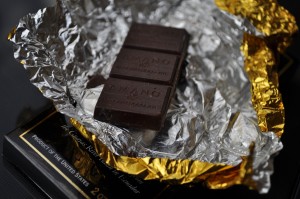
One of the great things about Amano is the obvious passion that goes not only into their bars, but also into the relationship between their company and the farmers and communities who cultivate the cacao used for their chocolate. You can read the stories behind Guayas and Amano’s other bars here.
Their website also features a fairly extensive and useful write up on tasting chocolate here.
We’ve got a wide range of Amano’s bars stocked in the Shop, so come in and test one (or two, or three…) out – you won’t be disappointed.
For that extra citrus kick – Valrhona Manjari Orange
Madagascar chocolate is an easy sell for me – I love the flavour of dried fruits, the slight spiciness, and mostly, the citrus. Of course, Valrhona was the one to step up with this flavoured bar, studded with candied orange rind, to give their 64% Manjari that extra edge. Valrhona’s efforts did not go unnoticed – they were awarded Gold for this one in 2009, at the Academy of Chocolate‘s annual competition.
Valrhona always does a great job in the tempering department, and this one has their characteristic sheen. I also love the light orange-brown colouring on this one, which hints at the citrus flavours to come.
Of course this bar smells as expected – like oranges. But a cinnamon-cloves scent also brings up the rear… definitely worth waiting for.
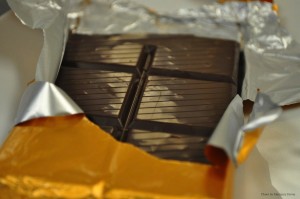
While I don’t generally select Valrhona’s Manjari chocolate for my Madagascar fix, here its light, crisp fruit flavours provide a perfect base for those flavourful chunks of orange. For me, this is exactly what their Manjari chocolate needs – a big hit of that sweet, acidic citrus that I love in other Madagascar chocolates.
In the end, I think it is this bar’s versatility that carries it a long way – whether you need a mid-day (or morning) pick-me-up, or a refreshing yet decadent finish to a winter meal, this one certainly delivers.
Let us know what you think of this bar! Also, if you have any favourite bars you would like us to post on, leave a note below!
Chocophilia Spiced Drinking Chocolate: A truly grown-up drink!
In this entertaining article in the Edmonton Journal, Liane Faulder had two pre-teens test our four types of hot chocolate. The kids found our drinking chocolate to be a little to spicy, but Liane said that she “loved the Chocophilia, which is best in small doses, like caviar. Thick and slightly bitter, the drink spread a warm tingle through the back of my throat and made me want to sigh with pleasure, and gratitude.“
We could not have said it better!
New products arrive at The Cocoa Room
We have recently brought some new products into the store for you chocolate connoisseurs.
Coppeneur is a German chocolate maker, and we decided to carry their chocolate, because we find their quality to be excellent. Their organic single plantation bars are truly delicious. Also check out the Coppeneur filled bars in flavours such as Walnut & Cognac or Chili & Highland Whisky.
Because so many of you told us that you liked the Claudio Corallo line of chocolates, we stocked up once more. The popular crystallized ginger bars are back, and we have also added a delicious 70% dark chocolate with cocoa nibs. My personal favourite, the 80% with crystallized sugar, is back too.
We continue to carry the Pralus “Les tropiques du chocolat” line, which features single origin 75% chocolates from all over the world. This time we are testing out the mild and slightly “hazelnutish” Venezuela and the earthy Sao Tome & Principe, which has a slight hint of mushroom. And for the first time we have brought in the Pralus Fortssima with an 80% cocoa content.
Also new are Domori’s Carenero Superior, a very smooth 70% chocolate from the Barlovento region in Venezuela and a 70% super-fruity Madagascar (definitely on my top 3 list now). Finally, for those of you who have been eagerly waiting its arrival, the Domori Porcelana is back.
Nina









